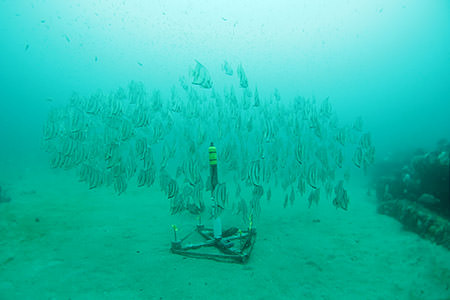Soundscape

A coral reef is a bustling community with snaps from shrimp, grunts from fish, and even the occasional click of a dolphin. Understanding the sounds on the coral reefs can help scientists look at diversity and the population of animals on the coral reef. They can also shed some light on how humans use the reef, such as listening to the hum of a boat engine going by.
Scientists put underwater microphones, called "hydrophones," underwater to record the soundscape or sounds of a particular location. This project was started in 2018, and scientists have been examining the sound information to translate sound into real information about the health of this ecosystem.
Researchers can also listen for how the sounds around coral reefs change as the reefs and ocean changes. If a coral reef gets quieter, there might be less animals that are calling it home. If coral restoration is successful in a location there might be more diverse sounds recorded by the equipment.

Hum, Crackle, Knock: Monitoring Reef Habitats in Florida Keys National Marine Sanctuary
Learn more about the Soundscape research in Florida Keys National Marine Sanctuary.

Sanctuary Soundscape Monitoring Project (SanctSound)
Learn how NOAA and the U.S. Navy are working to better understand underwater sound within the National Marine Sanctuary System.

Can Scientists Train Machines to Listen for Marine Ecosystem Health?
Researchers are testing the use of artificial intelligence and machine learning technologies to detect changes in ecosystem health.

